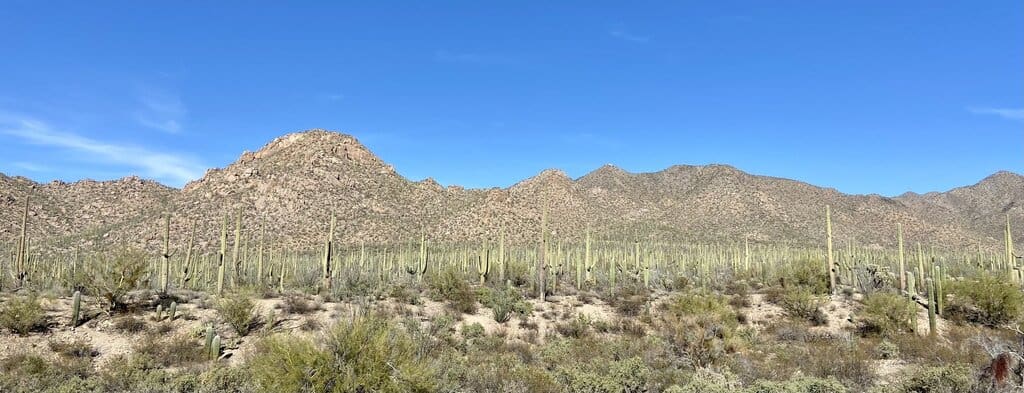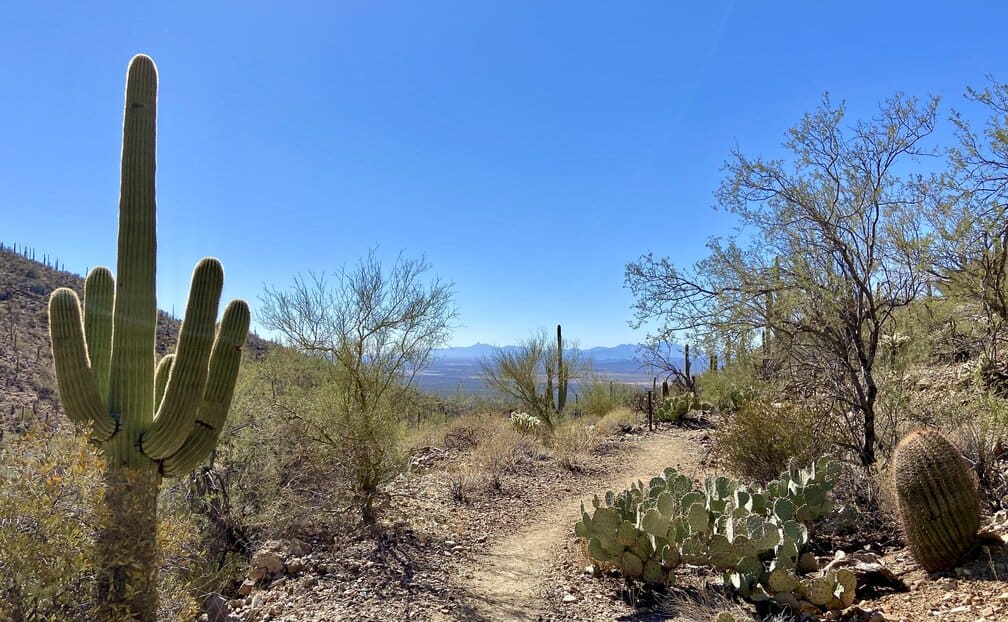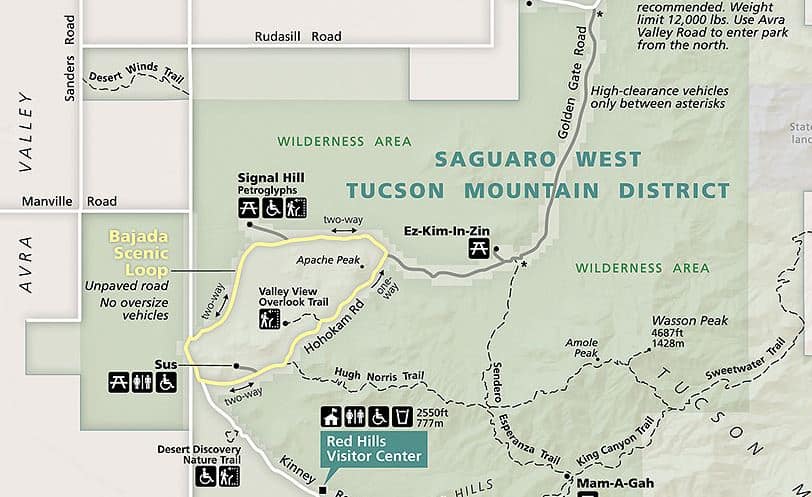There is just something special about the desert. And on top of that, the saguaro cactus is special. It can live 200 years and grow 3 stories tall. And it only grows in the Sonoran desert in Arizona (though there are similar cacti in Bolivia and Mexico).
While saguaros can be seen all over southern and central Arizona, Saguaro National Park has the highest concentration of them. There are two separate sides of the park, with Tucson in between. Here we will specifically discuss Saguaro National Park West.
Note: this article contains affiliate links, which means that should you purchase something or get a quote through them I may make a small commission at no additional cost to you. This helps keep the site running with up to date information. I do not represent Booking.com or Discovercars.com. This is information only and not a recommendation to buy the product mentioned in this article.
Saguaro National Park West – What You Need to Know
Where is Saguaro National Park?
Saguaro National Park is just outside of Tucson in southern Arizona. Tucson is the second largest city in Arizona and has excellent Mexican food. The park is split into two sections, east and west. Saguaro National Park West is in the mountains on – you guessed it – the west side of the city.
How to get there
You’ll need a car to get to Saguaro National Park. Rental cars from Tucson airport are pretty cheap, as low as $25/day, and the north entrance to Saguaro National Park West is barely 30 minutes from the airport.
Depending on where you are coming from, it might be easier to just book a direct flight to Phoenix and make the 90 minute drive down I-10. Or better yet, do it as part of a American Southwest desert road trip throwing in Monument Valley and Las Vegas.
You can use the link below to find a great deal on a rental car from the Tucson Airport or anywhere else in the US.
Click here to book a great deal on a rental car in the US!
Size of the park
Saguaro is one of the smaller National Parks in the National Park Service system. The West side is smaller than the East side, and the highlights can be seen in half a day, a full day with hiking added. There are not a lot of roads to drive so most exploration is done by foot.
Terrain
This is the desert, so expect to get a bit dusty. The park is mountainous and covered in sharp, prickly cacti and other dangerous vegetation. Trails are well laid out, so don’t venture too far off trail or you might end up tripping and falling into a cactus, and that will not feel great. There are rattlesnakes around, but chances you cross paths with one is slim.

Fee to enter Saguaro National Park West
Saguaro is $25 per vehicle. Like some of the other less-visited national parks, there is no entrance station to Saguaro West. Visitors are asked to pay the fee at the visitor’s center. You’re on the honor system here, but please don’t cheap out on our national parks and pay the fee. With NPS funding cut in recent years, visitor fees are more important than ever for maintaining the USA’s national treasures.
If you have the Interagency Pass, then you don’t have to do anything. If you don’t I highly recommend it if you will be visiting more than 3 parks in a 12 month period. It’s only $80 and pays for itself after a few parks. You can get it here (make sure to order a month or so before you need it).
Weather
This is the desert. It’s sunny nearly every day of the year and it’s pleasant in the winter and deadly hot in the summer. In the winter, daily highs are around 65-70 degrees and the lows can get around freezing. If you’re coming in peak winter, hiking will be more comfortable in the later morning and afternoon.
It is possible to visit Saguaro in the summer and many people do. If you do, though, be sure to start out on the trail as soon as possible, like at sunrise and try to be done by 10 AM. Little nature walks can easily be done in the brutal heat, but any sort of intense hiking can be dangerous when it’s 115 degrees outside.
When to visit Saguaro
If you have a death wish, summer might be a good time for you to explore the park. If you’re not looking to die of heat exhaustion though, late fall, winter, or early spring are probably your best bets.
I most recently went in peak winter – February – and it was absolutely lovely, mid 70s and not a cloud in the sky. You can still go in summer – and I have, but you have to be mindful of the heat. For a more in-depth look at the seasons in Saguaro fellow blogger Cat prepared this extensive guide to the best times to visit Saguaro.
Where to stay
Unlike most American National Parks, Saguaro is almost in a city. Tucson splits the park in two and has all the accommodation options you could ever want. If you want to stay in the park, you’ll have to do some backcountry camping, as there are no developed campsites in the park. Though there are numerous camping opportunities in the local parks around Saguaro (which are still covered in cactus-clad mountains)
Camping: Gilbert Ray Campground in Tucson Mountain Park.
Budget: If you need to stay in one of the budget hotels in Tucson go with the University Inn. Avoid the others.
Mid-Range: There are a lot of hotels between $100-$200 a night in Tucson. The Country Inn and Suites by Radisson is a good option near the highway for ease to the park.
Splurge: You can’t beat the JW Marriott Tucson Star Pass Resort and Spa just outside Tucson Mountain Park.
For other hotels check out the listings on booking.com and you’re sure to find something great!
And in the desert, when the sun comes up, I couldn’t tell where heaven stopped and the earth began. It was so beautiful.
Forest Gump
How to hike Saguaro National Park West
There are quite a few hiking trails to choose from in Saguaro National Park West. After a lot of research I chose the route below.
This route goes from Sendero Esperanze, a small parking and picnic area at the end of a dirt road to the top of Wassen Peak and down through a valley before hiking back up the ridge and back to the parking lot. I highly recommend this route for peace and quiet and lovely views. I started this hike at about 10 AM on a Sunday morning in February and it was perfect.
From the parking lot it was a mostly flat leisurely stroll through the desert brush for about the first mile. The path was dusty but easy to follow, with saguaros and other desert cacti lining each side. After the first mile it was a steady climb the rest of the way to Wassen Peak, but nothing that steep.
Anyone with a mild level of fitness can do this in the winter. As you hike up the ridge to the peak you are treated with some great views of the cactus-clad valleys below. The best part is you’re almost alone in the desert. In the first hour of the hike I must have seen maybe 5 other humans.
To the top of the peak
Just before the main push to the top of the mountain you meet up with the Sweetwater Trail, where you’ll start to see more people. This is an alternate trail to Wassen Peak that starts from outside the park and it more favored among locals.
The peak itself isn’t really anything special. There are nice views, but not really any saguaros up there. I prefer views with saguaros in the foreground, so I took more photos from the trail than from the top.

As I was heading back down the mountain I decided I was enjoying the scenery too much and didn’t want to go back to the car yet. So I decided to head back the other way down to the King’s Canyon Trail and walk through the valley floor. I passed some beautiful saguaro formations – again almost totally alone – as I walked the mostly flat valley.
There was one last climb up the ridge before I met back up with the trail that would take me back to the parking lot. In total it was about 10 miles and I did it in a little over 3 hours. I loved every step of it and I hope you do too.
What Else to See and Do in the Park
Saguaro National Park West is small, but there are a few other spots you should hit on top of your main hike. On your Google maps, type in “Picture Rocks Trailhead” to get directions from wherever you are coming from. From there follow Picture Rocks Road through the park.
Note that while Google might tell you that you can take Golden Gate Road – a narrow dirt road – from Picture Rocks Road, you cannot. That part of the dirt road is not accessible. So you have to leave the park and enter again at the western entrance.

Turning back into the park from Sandario Road, you’ll get on that same dirt road – the accessible part though – and make your way towards the end of the road, just past Ez-Kim-in-Zin picnic area, where I started my hike. Along the way, be sure to stop at Valley View Overlook trail for a short walk through some saguaros to a view of the inhabited valley below.
If you’re not doing a big hike from Sendero Esperanza, you don’t have to follow the dirt road all the way up there, but can instead continue the loop towards Signal Hill. There is a picnic area at Signal Hill as well, and a short hike to some petroglyphs.

After you’ve driven the dirt road loop (in yellow on the park map), you can head down Kinney Road to the Red Hills Visitor Center. I’m not one to spend much time at visitor centers, but there are some nice exhibits and you can learn a lot about the ecology of the region from some of the displays.
After leaving the visitors center, you’ve pretty much covered Saguaro West. If you chose not to do a big hike, you probably only spent about 2-3 hours in the park. But you definitely got some great views of those iconic Arizona saguaros!
Not just saguaros
Saguaro National Park is full of other types of cactus, not just the famous green giants. My second favorite type of cactus is the cholla. It’s a fuzzy looking cactus that is a bunch of little prickly balls combined into one funky bush.
You’ll also find organ pipe cactus, rainbow cactus, and endless prickly pear (but you can see those everywhere, even northern Virginia where I live, so I don’t get too excited about those). Of all types of plants, cactus is definitely my favorite. A plant that doesn’t really need water and can literally kill you. How bad ass is that?


Around Saguaro National Park West
Saguaro National Park is not the only place to see the saguaros and hike the mountains west of Tucson. There is also Tucson Mountain Park, which is basically just a continuation of Saguaro West, but owned by the local government instead of the federal government. There is no admission fee to Tucson Mountain Park, and I saw many more people there compared to Saguaro West, mostly locals.
I stayed in Tucson Mountain Park for sunset, as it’s actually a better place to catch an epic desert sunset, better than anywhere in the national park. I hiked a bit down from the parking lot at Gates Pass to get a nice view of the valley below with some big saguaros in front of me.
The cover photo from this article is actually not even from Saguaro West, but from Tucson Mountain Park. Sneaky, I know. Get there well before sunset so that you don’t miss out on a parking spot. It’s a popular place for locals.
Frequently Asked Questions
Should I go to Saguaro National Park East or West?
Visiting Saguaro National Park East or West is a personal decision. If you’re short on time, the west side can be easily seen in just a few hours. If you have an entire day, the east side might be better for you. If you have multiple days, visit both!
How long does it take to drive through Saguaro National Park West?
Driving through Saguaro National Park West takes about an hour if you’re not stopping anywhere. But why would you do that? Get out of the car and explore the desert! Saguaro National Park East is bigger, but actually has less paved road. The entire loop is only 10 miles, so it doesn’t take too long.
Does Saguaro National Park West have a visitors center?
Saguaro National Park West has a visitors center near the south end of the park. The Red Hills Visitors Center has all sorts of exhibits about desert flora and fauna, as well as an awesome view of the saguaro-covered mountains.
How much time do you need in Saguaro National Park?
It’s nice to have an entire day in Saguaro National Park. This allows time for adequate hiking and getting away from the roads. If you don’t plan on hiking it’s easy to see either side of Saguaro in a half day.
Final Word
The American Southwest is one of my the most unique places in the world. The desert landscapes of Arizona, southern Utah, parts of Nevada, and parts of California is simple stunning. There is so much variety in this part of the world.
You can catch the sunset over a seas of giant green cacti one day and be hiking around red rocks covered in pine trees the next, no cacti in sight. I recommend Saguaro as part of a longer tour of the American Southwest, but however you do it you are going to love it!


1 comment
[…] One of the best National Parks to visit in May is Arizona’s Saguaro National Park. […]